4/23/2019
By Alma Lowry

Professor Doug Tallamy, award winning author of numerous books and articles on the benefits of native gardening, speaks at the ground=breaking ceremony of ASLF’s Urban Tree Nursery
Atlantic States Legal Foundation (ASLF) is committed to green. Our core mission includes greening the urban core through green infrastructure, like rain gardens, to channel and manage stormwater, and tree plantings to buffer contaminated run-off and to provide shade, habitat, and other benefits. But our work extends beyond simply greening the urban core – ASLF is committed to using native shrubs and trees to reach this goal.
Today, the benefits of urban greenspace are widely understood. Trees, shrubs, and other greenery can help purify the air and water. Increased tree canopy provides shade and reduces local temperatures. Vegetation can act as a noise buffer. Access to green space reduces anxiety and provides opportunities for active pastimes, improving both mental and physical health. Native and non-native plants alike may provide these benefits. Native plants, however, provide more.
Because native trees and shrubs have evolved along with local insects, birds, and other wildlife, they may be particularly hospitable to these populations. For example, a 2010 study found that native maple species (red maple) support three times as many butterfly and moth caterpillars as did non-native maple species (Norway maple). Because native species were naturally selected for local conditions, they tend to require less maintenance, fewer chemical interventions, and less watering than non-native species.
Many non-native species have become so common that we have forgotten their origin. Norway Maples, for example, are among the most common street trees across New York State. Japanese Cherry, Callery Pear, and other flowering trees are widespread due to their showy spring displays and elegant shapes. However, many have become invasive, spreading beyond our gardens and out-competing native plants. Common invasive species include the aforementioned Norway Maple and Callery Pear, as well as the Tree of Heaven, Japanese Barberry, and Autumn Olive.
Luckily, native trees, shrubs, and flowers can be both beautiful and environmentally sustainable, and there are varieties available to suit every need. Consult with your local chapter of Wild Ones or check on-line for advice from organizations such as National Wildlife Federation to find appropriate native plants for your locale. The Habitat Gardening Club of Central New York is a fantastic resource for incorporating native plants into your residential landscape, including an annual native plants shopping guide, landscape design workshops, and local garden tours. The 2019 shopping guide was just released.
And, if you’re in the Syracuse area, ASLF’s tree and shrub nursery can help you bring the benefits of native greenery home. While we hope to include genetically local seedlings from our Mother Tree program soon (see our October 2018 web article for more information), we maintain a stock of native trees and shrubs from a trusted partner. Check out our current inventory on-line. And join us in committing to native trees, shrubs, and other plants. As Professor Tallamy, an entomologist and author of the award winning book, Bring Nature Home, says – let’s garden as if life depended on it!
